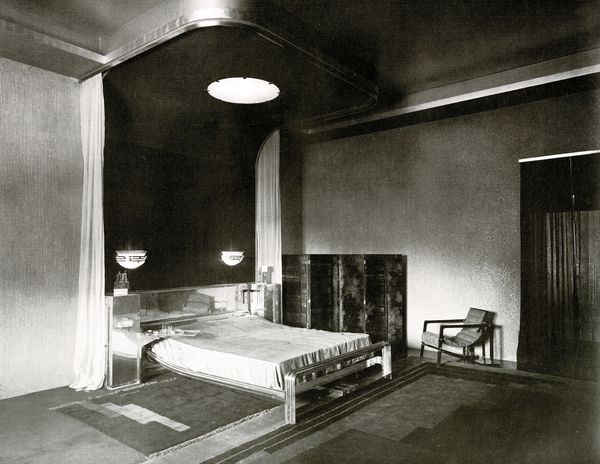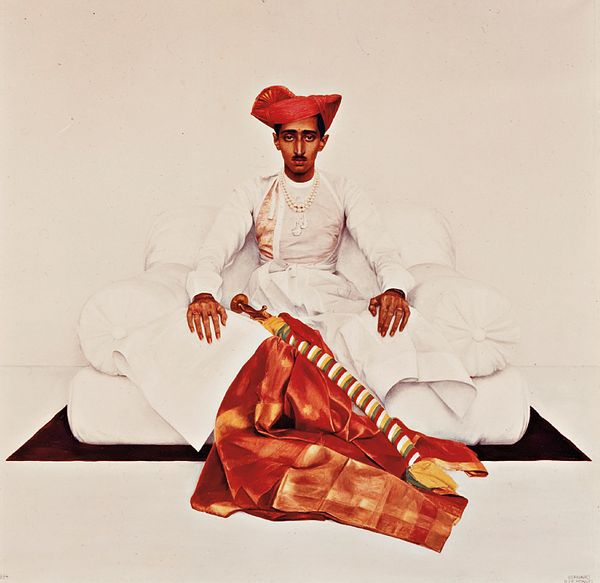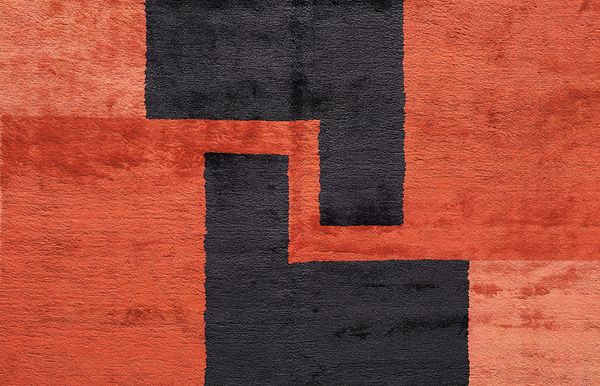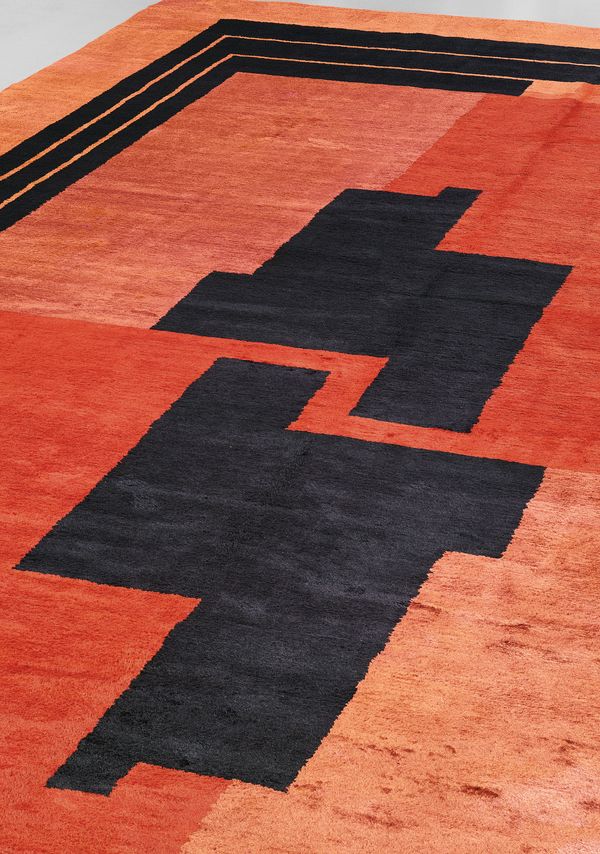The Manik Bagh Carpet (detail)
This stunning hand-woven carpet was commissioned and made for the bedroom of the Maharaja Yeshwant Rao Holkar II (1908-1961) of Indore, as an expression of his personal taste, princely status and intellectual connoisseurship. Created for the Maharaja’s new palace, Manik Bagh ('Gardens of Rubies'), in Indore, India, it is one of several commissioned for the palace from the leading Parisian avant-garde carpet designer Ivan da Silva Bruhns (1881-1980). The fantastic building and its progressive design scheme were the product of two bright young visionaries, the Maharaja and the German architect, Eckart Muthesius (1904-1989) whom he serendipitously met whilst at Oxford University. The resulting Manik Bagh (1930-1934) was a unique example of chic International Modernism in Asia.

The carpet in situ, Manik Bagh Palace, photographed by Eckart Muthesius, 1933 © ADAGP, Paris and DACS, London 2016.
The Maharaja and his beautiful wife, Maharani Sanyogita Devi (d. 1937) of Indore, travelled to Europe for an English education in 1925. They made an elegant and glamorous couple, enjoying the extravagances of high society and developing a taste for European Art Deco. On returning to Indore to succeed his father in 1930, Shri Yeshwant took with him plans from Muthesius for a new palace suitable for an internationally educated prince looking to the future of his state and India. Muthesius had grown up immersed in the newly developing ideals and forms of modernism, as propounded by his father, in Glasgow, Berlin, Paris and London. He undertook commissions for eminent patrons in India, promoting the new Modern Style.
Together, the royal patron and the enthusiastic architect revelled in creating and collecting pieces which manifested the fusion of traditional craft with the new machine aesthetic. Manik Bagh was constructed like a Mughal palace around a central garden, but there the comparison with a traditional Indian palace ends. It had the latest in building technology, such as mechanised air-conditioning and tinted window glass with metal frames. The rooms were of a modest size for an Indian royal home, but no expense was spared in using the best-quality materials and craft, combined with newly developing, functional, series-produced manufacture.
Together, the royal patron and the enthusiastic architect revelled in creating and collecting pieces which manifested the fusion of traditional craft with the new machine aesthetic.
Ivan da Silva Bruhns Unique and important carpet, designed for the Maharaja of Indore’s bedroom, Manik Bagh (Garden of Rubies) Palace, Indore, circa 1930
Throughout the palace, including the external window shades, the dominant colour theme was of various shades of reds and black. This continued in a more subdued form into the Maharaja’s bedroom, and culminated in the largest and most striking piece in the room, the sumptuously-produced carpet designed by da Silva Bruhns. The rich russet reds are reminiscent of the traditional Berber rugs that made a great impact on da Silva Bruhns afer he saw them in Paris in 1917.
By the early 1920s, his design style had shifted to more geometric and symmetrical compositions, with reduced palette patterns. His reputation fourished. He was commissioned by many artistes-décorateurs and created striking carpets for several exhibits at the 1925 International Decorative Arts Exhibition in Paris, where he won frst prize in the textile section. The same year he established a carpet factory in the Parisian suburb of Savigny-sur-Orge. Using the French Savonnerie knot weaving technique, the carpets were made with superb wools shipped from Argentina and Australia. To compensate for the reduced knots, compared with a traditional Persian technique, each knot was made up of ten or more tufts, giving a specifcally rich, soft depth to the pile.

The carpet in situ, Manik Bagh Palace, photographed by Eckart Muthesius, 1933 © ADAGP, Paris and DACS, London 2016.
The luxurious carpet covered the full width of the bedroom and the area between the doorway and the bottom of the bed. While da Silva Bruhns believed that carpets should be a foil to the furnishings and a subtle support to the room scheme, this expanse of strong floor colour, contrasting with the pale gold and beige tones of the walls and the sparseness of the furnishing, made a great impact on the room’s ambience. The pattern of overlaying cubist forms is in a palette of three red tones, from rich russet red to sofer salmon pink. These contrast with the black geometric interlocking islands in the centre and the black parallel lines which define the rectangular shape of the carpet.
These bold, warm, passionate tones, along with the more masculine use of black, were also prominent in portraits that the Maharaja had painted in his Maratha dress at that time. The same russet reds, which make a striking contrast with the paler white colours of his dress, cushions and draped silks, can be seen in both his investiture costume, which has a red turban with black drop-jewels, and the striking image of him by the society artist Bernard Boutet de Monvel in 1934.

Bernard Boutet de Monvel, The Maharaja on Indore in traditional Maratha Dress, circa 1929 © ADAGP, Paris and DACS, London 2016.
The parallel lines of the carpet mirror and accentuate the horizontal lines in the square forms and long metal handles of the furniture in the room, such as the dressing table in rosewood – designed by Muthesius, along with the lighting. The layout included pieces designed by other leading designers of the day, such as the Transat chair by Eileen Gray (1878-1976) and the now-iconic chrome and leather chaise longue by Le Corbusier (1887-1965) and Charlotte Perriand (1903-1999). The great bed, with its headboard sprayed red and polished duralumin corners, was designed for Manik Bagh by Louis Sognot (1892-1969) and Charlotte Alix (1897-1987). Before being shipped to India, it was exhibited in an ensemble of colonial furniture at the Salon d’Automne of 1930. Indeed, the whole commission was promoted and widely reported as revolutionary, with elegant schemes being transformed by machines. Articles and photographs were published in Paris (Art et Décoration, 1932), India ('Housing India in Modern Style', The Illustrated Weekly of India, 1934) and London (The Studio Yearbook, 1933).
The auspicious Manik Bagh project took nearly a decade to complete, but after his wife died and Muthesius had to leave India in 1939, Shri Yeshwant spent very little time there, and Manik Bagh was left suspended in time until the early 1970s. Afer the ending of official privileges to maharajas in 1971, the palace became a government building, and many of the beautiful furnishings went to sale at Sotheby’s, Monte Carlo in 1980. The bedroom carpet was sold there in 1987, and subsequently at Sotheby’s, London in 1996, to the current owner.
— Fiona Leslie, Author

